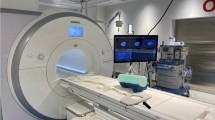Abstract
Background
The pudendal nerve may become entrapped either within the pudendal canal or near the sacrotuberous ligament resulting in a partial conduction block. The goal of the present anatomical study was to assess a new transgluteal injection technique in terms of the precise injection site and the resulting distribution of the injected agent.
Materials and methods
This study was carried out using eight fresh human cadavers. An epidural needle with a removable wing was inserted and the catheter position visualized using MRI. Through the catheter 10 ml of gadolinium contrast medium was injected into three of the cadavers. A further four cadavers were injected with latex and blue pigment and the pelvi-perineal area of each then separated from the trunk for freezing before being cut into 4–8 mm thick sections with an electric bandsaw. One final cadaver was injected with a mix of gadolinium (5 ml) and latex (5 ml) and both the MRI and anatomical procedures outlined above were performed.
Results
Using MRI, we clearly imaged both the site of injection, near the trunk of the pudendal nerve, and the gadolinium contrast medium in different pelvic and perineal areas and around the fascia of the obturator internus and levator ani muscle. Concerning the anatomical study, latex was observed mainly around the sacrotuberous ligament, along the obturator internus muscle and in the perineal area in contact with the dividing branches of the pudendal nerve. The mixed injection of latex and gadolinium in the pudendal canal was found with the same localization between MRI and anatomical studies.
Conclusion
This easily performed technique should provide a new approach for treating perineal neuralgia via pudendal nerve block in the consultation room without the need for computed tomography.





Similar content being viewed by others
References
Amarenco G, Lance Y, Ghnassia RT, Goudal H, Perrigot M (1988) Syndrome du canal d’alcoock et névralgie périnéale. Rev Neurol 44(89):523–526
Amarenco G, Kerdraou J, Bouju P, Le Budet C, Cocquen AL, Bosc S, Goldet R (1997) Treatments of perineal neuralgia caused by involvement of the pudendal nerve. Rev Neurol 153(3):331–334
Bensignor M, Le Henaff M, Labat JJ, Robert T, Lajat Y (1993) Douleur périnéale et souffrance du nerf honteux interne. Cah Anesthesiol 41(2):111–114
Bensignor M, Le Henaff M, Labat JJ, Robert T, Lajat Y, Papon M (1990) Douleur périnéale et souffrance du nerf honteux interne. Doul Analg 3:99–101
Choi SS, Lee PB, Kim YC, Kim HJ, Lee SC (2006) C-arm-guided nerve block: a new technique. Int J Clin Pract 60(5):553–556
Juenemann KP, Lue TF, Schmidt RA, Tanagho EA (1988) Clinical signifiance of sacral and pudendal nerve anatomy. J Urol 39:74–80
Labat JJ, Robert R, Bensignor M, Buzelin JM (1990) Les névralgies du nerf pudendal: considérations anatomo-cliniques et perspectives thérapeutiques. J Urol 96(5):239–244
Loukas M, Louis RG, Hallner B, Gupta AA, Withe D (2006) Anatomical and surgical considerations of sacrotuberous ligament and its relevance in pudendal nerve entrapment. Surg Radiol Anat 28:163–169
Moore DC, Thomas Ch (1975) C Regional block. Springfield III
Pace JB, Nagle D (1976) Piriform syndrome. West J Med 124:435–439
Robert R, Labat JJ, Lehur PA, Glemain P, Amstrong O, Leborgne J, Barbin JY (1989) Réflexions cliniques, neurophysiologiques et thérapeutiques à partir des données anatomiques sur le nerf pudendal (honteux interne) lors de certaines algies périnéales. Chirurgie 115:515–520
Robert R, Prat-Pradal D, Labat JJ, Bensignor M, Raoul S, Ribai R, Le Borgne J (1998) Anatomic basis of chronic pain: role of the pudendal nerve. Surg Radiol Anat 20:93–98
Schmidt RA (1989) Technique of pudendal nerve localisation for block of stimulation. J Urol 14:1528–1531
Steiner C, Staubs C, Ganon M, Buhlinger C (1987) Piriformis syndrome: pathogenesis, diagnosis and treatment. J Am Ostéopath Assoc 87:318–323
Wesselmann U, Burnett AL, Heinberg LJ (1997) The urogenital and rectal pain syndromes. Pain 73:269–294
Acknowledgments
Special thanks go to Michel Bossy and members of the imaging service for their helpful contributions to this study.
Author information
Authors and Affiliations
Corresponding author
Rights and permissions
About this article
Cite this article
Prat-Pradal, D., Metge, L., Gagnard-Landra, C. et al. Anatomical basis of transgluteal pudendal nerve block. Surg Radiol Anat 31, 289–293 (2009). https://doi.org/10.1007/s00276-008-0445-z
Received:
Accepted:
Published:
Issue Date:
DOI: https://doi.org/10.1007/s00276-008-0445-z




